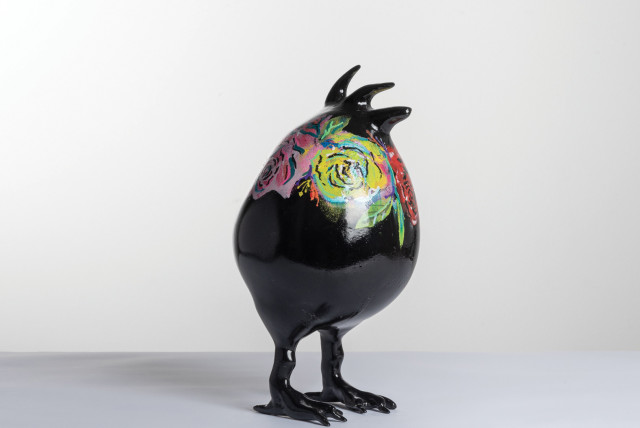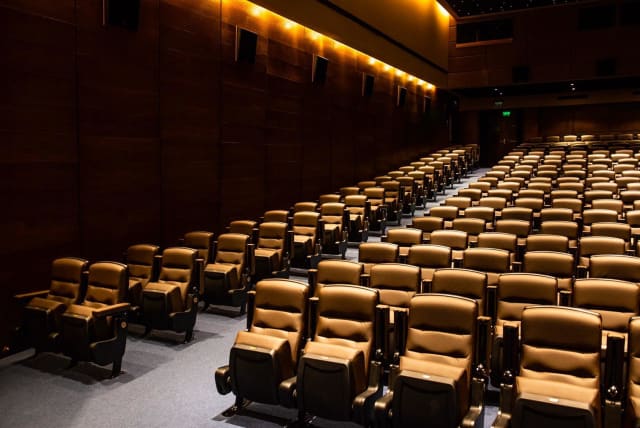At the age of 88, Yehuda Granit has something to say, something plaintive and heartfelt. Fortunately, he has the technical means and creative know-how to express his thoughts and feelings in strident, tangible, and visual form and offload some angst.
The end product of Granit’s artistic, emotional, and cerebral processes is displayed at the Artspace gallery in southern Tel Aviv. It goes by the quizzically satirical name of “The War Is Getting Excited” and makes for pretty intriguing and compelling viewing.
There is plenty to see and feel in Granit’s section of the display facility. The 16 works, deftly arranged by curator Shirley Wegner, are also infused with the octogenarian’s opinion on political developments in this part of the world.You can sense Granit’s frustration and pain at how things have been going over the past few years.
His collection of sculptures, woodcuts, linoleum cuts, and monotype prints howls and yelps out at you, almost literally. Self-portrait No. 2, for example, leaves you in no doubt regarding the former lawyer and judge’s sentiments. The context of Norwegian artist Edvard Munch’s iconic The Scream naturally comes into the inspirational equation.
But this is sculpture and not just any old sculptural, textural effort. Notwithstanding his more than four score years here on terra firma, Granit infuses his works with great physical strength as his chosen raw material is primarily iron, which comes with the sculpting territory.
There is nothing subtle about Self-portrait No. 2 or many other exhibits. Granit is not generally looking to follow a pussyfoot line of attack. This is mostly about spilling the emotional beans and imparting raw emotions. The work above and the vast majority of the other “The War Is Getting Excited” components convey a sense of snapshots and invite the observer to connect the dots and arrive at a composite lay of the current affairs land here.
There is also an oxymoronic element to Granit’s endeavor. Take, for example, Color Red in the Gaza border communities. The iron sculpture shows three female figures who look like mothers tenderly embracing their daughters in a protective gesture. The background is, of course, red. The loving maternal care for her offspring is rudely and inversely underscored both by the implication of a life-threatening situation and the unforgiving nature of the metal.
Reflections of conflict

The vibrant and motive elements are enhanced by Granit’s connection with the brutal Hamas attack in the South and its ongoing fallout. His wife’s cousin, Gadi Moses, is a hostage in Gaza. Moses’s partner, Efrat Katz, was killed when an IAF helicopter fired on a car on October 7, in which terrorists were taking her to Gaza. And several of Moses’s ex-wife’s family members were hostages who, thankfully, have since been released.
Those bloodcurdling events and close connections fueled some of the exhibits but also Granit’s abhorrence of war and violence in general and his wish for a kindlier take on life here.
Images taken from media coverage of political events provide him with food for thought and subject matter for artistic interpretation. Stellar actress and comedienne Orna Banai and her expression of anguish, documented and disseminated by TV cameras at a protest about the hostage situation back in January, appear in a stark-looking monochrome woodcut called Now.
And there is a place for the mother of a mentally challenged Palestinian boy killed by an Israeli policeman in a linocut called Umm Ayad. Media images that, presumably, are familiar to large slices of the public make for an efficient, enticing hook.
One of the exhibition’s most impressive and captivating items is Cross Checkpoint No. 2, a 1.8-meter-tall metal sculpture.
“As you can see, the figure is in the shape of a cross,” Granit points out. Indeed, there was no missing the crucifix arrangement as we see a Palestinian woman from the back, arms outstretched and ready to be frisked as her bag hangs limpidly from one shoulder. “I originally had a figure of an Israeli soldier in front of her, but then I realized there was no need,” Granit smiles.
There is little in the way of i-dotting and t-crossing in “The War Is Getting Excited.” The viewer can often complete the picture with their thoughts and feelings.
The sculpture gets a reprise in the Cross Checkpoint No. 1 linocut, and there are additional instances of a sort of call-and-response rapport between other works.
Banai’s primeval cry echoes Granit’s own in his self-portrait and that of the grieving mother in Umm Ayad.There is another cry in an instantly recognizable skeletal iron sculptural work, albeit with no obvious outer signs. “That is based on Robert Capa’s photograph,” Granit advises more than a little superfluously.
The seminal war photographer took the frame during the Spanish Civil War, at the very moment a bullet hit a soldier. Granit’s reading captures the moment and the movement of “The Falling Soldier” with a schematic aplomb.
I was also fascinated by Granit’s move away from legal action to artistic enterprise. He says he got in on the creative act in his forties.
“I noticed that whenever I was abroad and went to a museum, I would gravitate towards sculpture,” he recalls.With that realization fully taken on board, he set about learning the grammar and syntax of the discipline, getting some valuable hands-on experience, and studying with celebrated sculptors Nachum Enbar and Zvika Lachman.
He began devoting himself to the art form on a full-time basis after retiring from the judicial bench at the age of 70.“I did my first sculpture in an avocado stone,” Granit chuckles. “Then I moved on to clay, wood, stone, and metal.”
He also studied calligraphy, and despite the unavoidably coarse nature of the shapes he chisels and saws through some of his metal works, there is an alluring cohesive flow dynamic in there, too.
Granit clearly feels strongly about the subject matter and its associated sensibilities, and he expresses that powerfully, succinctly, and without excessive drama.
‘The War Is Getting Excited’ closes on May 25.For more information: https://www.artspacetlv.org







































































































